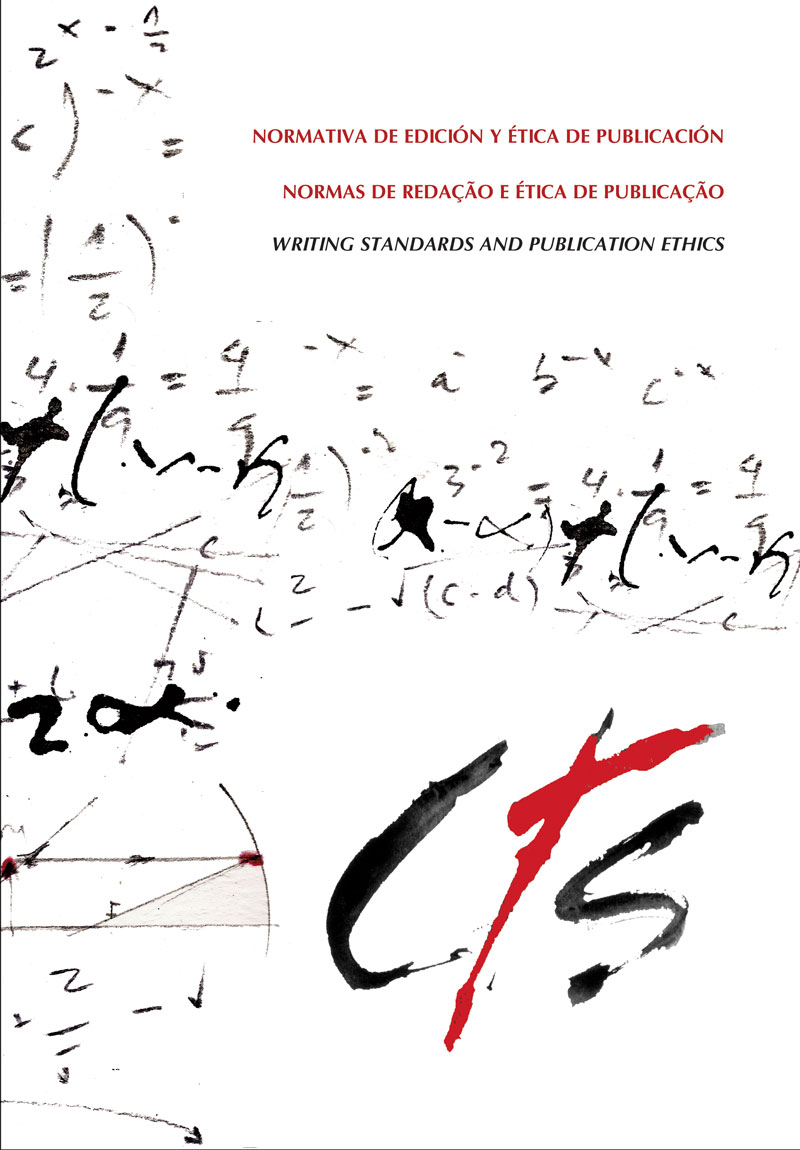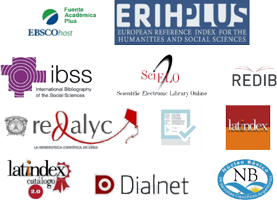Futuros tecnocientíficos: nuevos desafíos en torno a la geoingeniería solar
Palabras clave:
tecnociencia, Antropoceno, geoingeniería, cambio climático, Gran AceleraciónResumen
Desde mediados del siglo XX, la emergencia y la propagación de las tecnociencias ha acelerado vertiginosamente la transformación de las esferas naturales, habiéndose superpuesto a ellas un nuevo sistema interconectado: la tecnosfera, formada por múltiples objetos artificiales y sus diversas interrelaciones, las cuales suponen buena parte de los riesgos medioambientales de nuestro tiempo. Este artículo explora su expansión durante la Gran Aceleración socioeconómica del siglo XX a partir de dos rasgos característicos de la actividad tecnocientífica: el uso de simulaciones y la intervención meteorológica. Ambas prácticas confluyen actualmente en las propuestas de gestión de la radiación solar (GRS), cuyas pretensiones son la modificación y la regulación de las condiciones atmosféricas en aras de reducir el calentamiento global. Dada la actual crisis climática y los avances en esta geoingeniería, afirmamos que hay factores que suscitan la posible aparición de unas futuras tecnociencias del clima, en base a iniciativas privadas y plataformas de investigación como Future Earth. La previsión y prevaloración de los riesgos subyacentes son cuestiones a las que conviene anticiparse desde los estudios CTS y que, junto con otros desafíos, componen una agenda de problemas en torno al Tecnoceno: la época del impacto global de las tecnociencias en el Sistema Tierra.Descargas
Citas
Arias Maldonado, M. (2018). Antropoceno. La política en la era humana. Madrid: Taurus.
Asayama, S., Sugiyama, M., Ishii, A. y Kosugi, T. (2019). Beyond solucionist science for the Anthropocene: To navigate the contentious atmosphere of solar geoengineering. The Anthropocene Review, 6(1-2), 19-37.
Baskin, J. (2019). Geoengineering, the Anthropocene and the End of Nature. Cham: Palgrave Macmillan.
Beck, S. (2019). Coproducing Knowledge and Politics of the Anthropocene: The Case of the Future Earth Program. En F. Biermann y E. Lövbrand (Eds.), The Practices of Political Study in the Anthropocene (191-211). Cambridge: Cambridge University Press.
Bonnheim, N. B. (2010). History of climate engineering. WIREs Climate Change, 1(6), 891-897.
Boulton, G. (2018). The challenges of a Big Data Earth. Big Earth Data, 2(1), 1-7.
Byers, H. R. (1974). History of weather modification. En W. N. Hess (Ed.), Weather and climate modification (3-44). Nueva York: Wiley.
C2G2 (2019). Geoingeniería: la necesidad de gobernanza. Nueva York: Iniciativa Carnegie para la Gobernanza de la Geoingeniería Climática.
Cearreta, A. (2015). La definición geológica del Antropoceno según el Anthropocene Working Group (AWG). Enseñanza de las Ciencias de la Tierra, 23(3), 263-271.
Cera, A. (2017). The Technocene or Technology as (Neo)Environment. Techné: Research in Philosophy and Technology, 21(2-3), 243-282.
Cózar Escalante, J. M. (2019a). Ingenieros del Antropoceno digital: la enseñanza de las ingenierías en una época incierta. Revista Iberoamericana de Ciencia, Tecnología y Sociedad —CTS, 14(41), 185-196.
Cózar Escalante, J. M. (2019b). El Antropoceno. Tecnología, naturaleza y condición humana. Madrid: Los Libros de la Catarata.
Cressey, D. (2012). Cancelled project spurs debate over geoengineering patents – SPICE research consortium decides not to field-test its technology to reflect the Sun’s rays. Nature. 485(7399), 429.
Crutzen, P. J. y Stoermer, E. F. (2000). The ‘Anthropocene’. Global Change Newsletter, 41, 17-18.
Crutzen, P. (2006). Albedo enhancement by stratospheric sulfur injections: A contribution to resolve a policy dilemma? Climatic Change, 77, 211-219.
Dannenberg A. y Zitzelsberger, S. (2019). Climate experts’ views on geoengineering depend on their beliefs about climate change impacts. Nature Climate Change, 9, 769–775.
Doel, R. (2003). Constituting the postwar earth sciences: The military’s influence on the environmental sciences in the USA after 1945. Social Studies of Science, 33(5), 635-666.
Echeverría, J. (1999). Los señores del aire: Telépolis y el Tercer Entorno. Barcelona: Destino.
Echeverría, J. (2003). La revolución tecnocientífica. Madrid: Fondo de Cultura Económica.
Echeverría, J. (2009a). Interdisciplinaridad y convergencia tecnocientífica nano-bio-info-cogno. Sociologías, 22, 22-53.
Echeverría, J. (2009b). Los riesgos de la globalización. En J.L. Luján y J. Echeverría (Eds.), Gobernar los riesgos: ciencia y valores en la sociedad del riesgo (187-206). Madrid: Editorial Biblioteca Nueva.
Echeverría, J. (2015). De la filosofía de la ciencia a la filosofía de las tecno-ciencias e innovaciones. Revista iberoamericana de Ciencia, Tecnología y Sociedad —CTS, 10(28), 109-119.
Ellis, E. C. (2015). Ecology in an anthropogenic biosphere. Ecological Monographs, 85(3), 287–331.
Feichter, J. y Quante, M. (2017). From predictive to instructive: Using models for geoengineering. En M. Heymann, G. Gramelsberger y M. Mahony (Eds.), Cultures of Prediction in Atmospheric and Climate Science. Epistemic and Cultural Shifts in Computer-based Modelling and Simulation (178-194). Nueva York: Routledge.
Fleming, J. R. (2010). Fixing the sky: The checkered history of weather and climate control. Nueva York: Columbia University Press.
Fleming, J. R. (2004). Fixing the climate: Military and civilian schemes for cloud seeding and climate engineering. En L. Rosner (Ed.), The technological fix: How people use technology to create and solve problems (X–XX). Londres: Taylor & Francis.
Fleming, J. R. (2007). The Climate Engineers. Wilson Quarterly, 31, 46-60.
Forman, P. y Sánchez-Ron, J. M. (Ed.) (1996). National Military Establishments and the Advancement of Science and Technology: Studies in Twentieth-Century History. Dordrecht: Kluwer Academic Publishers.
Future Earth (2014). Strategic Research Agenda. París: International Council for Science.
Galle, N. J., Notoslawski, S.A. y Pilla, F. (2019). The Internet of Nature: How taking nature online can shape urban ecosystems. The Anthropocene Review, 6(3), 279-287.
Gärdebo, J., Marzecova, A. y Knowles, G. (2017). The orbital technosphere: The provision of meaning and matter by satellites. The Anthropocene Review, 4(1), 44-52.
Greenpeace (2017). Clicking Clean 2017: ¿Quién está ganando la carrera para construir un internet verde? Recuperado de: www.greenpeace.es.
Haff, P. K. (2013). Technology as a geological phenomenon: implications for human well-being. En C. N. Waters, Zalasiewicz J, M. Williams et al. (Eds.), A stratigraphical basis for the Anthropocene. The Geological Society of London (301-309). Londres: Special Publications.
Harper, K. C. (2017). Make it Rain: State Control of the Atmosphere in Twentieth Century America. Chicago: University of Chicago Press.
Harper, K. C. (2008). Climate control: United States weather modification in the cold war and beyond. Endeavour, 32(1), 20–26.
Heymann, M. y Achermann, D. (2018). From Climatology to Climate Science in the Twentieth Century. En S. White, C. Pfister y F. Mauelshagen (Eds.), The Palgrave Handbook of Climate History (605-626). Londres: Palgrave McMillan.
Heymann, M. y Hundebøl, R. (2017). From heuristic to predictive: Making climate models into political instruments. En M. Heymann, G. Gramelsberger y M. Mahony (Eds.), Cultures of Prediction in Atmospheric and Climate Science. Epistemic and Cultural Shifts in Computer-based Modelling and Simulation (100-119). Nueva York: Routledge.
Heymann, M., Gramelsberger, G. y Mahony, M. (2017). Introduction. En M. Heymann, G. Gramelsberger y M. Mahony (Eds.), Cultures of Prediction in Atmospheric and Climate Science. Epistemic and Cultural Shifts in Computer-based Modelling and Simulation (1-17). Nueva York: Routledge.
Hornborg, A. (2015). The Political Ecology of the Technocene: Uncovering Ecologically Unequal Exchange in the World-System. En C. Hamilton, C. Bonneuil y F. Gemenne (Eds.), The Anthropocene and the Global Environmental Crisis: Rethinking Modernity in a New Epoch (57-69). Nueva York: Routledge.
IPCC (2019). The Intergovernmental Panel on Climate Change. Recuperado de: https://www.ipcc.ch/.
IPCC (2014). Climate Change 2014: Mitigation of Climate Change. Contribution of Working Group III to the Fifth Assessment Report of the Intergovernmental Panel on Climate Change. Cambridge: Cambridge University Press.
Josephson, P. (2011). Technology and the conquest of the Arctic. The Russian Review, 70(3), 419–439.
Josephson, P. y Zeller, T. (2003). The transformation of nature under Hitler and Stalin. En Walker M. (Ed.), Science and Ideology: A Comparative History (124–152), Londres: Routledge.
Keith, D. W. (2000). Geoengineering the climate: History and prospect. Annual Review of Energy and the Environment, 25, 245-284.
Lamb, H. (1971). Climate-engineering schemes to meet a climatic emergency. Earth-Science Reviews, 7, 87-95.
López Cerezo, J. A. y Luján, J. L. (2000). Ciencia y política del riesgo. Madrid: Alianza.
Marchetti, C. (1977). On geoengineering and the CO2 problem. Climatic Change, 1, 59-68.
Marland, G. (1996). Could we/should we engineer the Earth’s climate? Climatic Change, 33(3), 275–278.
McNeill, J. R. y Engelke, P. (2016). The great acceleration: An environmental history of the Anthropocene since 1945. Cambridge: Harvard University Press.
McNeill, J. R. y Unger, C. R. (Eds.) (2010). Environmental histories of the Cold War. Cambridge: Cambridge University Press.
NASA (2007). Workshop Report on Managing Solar Radiaton. Moffett Field: Ames Research Center.
Philander, S. G. (Ed.) (2008). Encyclopedia of global warming and climate change. Thousand Oaks: SAGE.
Ortega y Gasset, J. (1939). Meditación de la técnica. Madrid: Biblioteca Nueva.
Quintanilla, M. A. (2017). Tecnología: un enfoque filosófico y otros ensayos de filosofía de la tecnología. México: Fondo de Cultura Económica.
Rayner S., Heyward C., Kruger T., Pidgeon, N., Redgwell, C. y Savulescu, J. (2013). The Oxford Principles. Climatic Change, 121(3), 499-512.
Rispoli, J. y Grinevald, J. (2018). Vladimir Vernadsky and the Co-evolution of the Biosphere, the Noosphere, and the Technosphere. Technosphere Magazine. Recuperado de: https://technosphere-magazine.hkw.de/p/Vladimir-Vernadsky-and-the-Co-evolution-of-the-Biosphere-the-Noosphere-and-the-Technosphere-nuJGbW9KPxrREPxXxz95hr.
Robinson, E. y Robbins, R. C. (1968). Sources, abundance, and fate of gaseous atmospheric pollutants. Estados Unidos: Stanford Research Institute.
Shaw, D. J. B. (2015). Mastering nature through science: Soviet geographers and the Great Stalin Plan for the transformation of nature, 1948–53. The Slavonic and East European Review. 93(1), 120–146.
Sloterdijik, P. (2016). Was geschah in 20. Jahrhundert? Berlin: Suhrkamp Verlag.
Steffen, W., Broadgate, W., Deutsch, L., Graffney, O. y Ludwig, C. (2015). The trajectory of the Anthropocene: The Great Acceleration. The Anthropocene Review, 2(1), 81-98.
Steffen, W., Rockström, J. y Richardson, K. (2018). Trajectories of the Earth System in the Anthropocene. Proceedings of the National Academy of Sciences, 11(33), 8252–8259.
Stephens, J. y Surprise K. (2020). The hidden injustices of advancing solar geoengineering research. Global Sustainability, 3(E2),1-6.
Spice Project (2013). Stratospheric Particle Injection for Climate Engineering. Recuperado de: http://www.spice.ac.uk/.
Stavins, R. N. y Stowe, R. C. (Eds.) (2019). Governance of the Deployment of Solar Geoengineering. Cambridge: Harvard Project on Climate Agreements.
Straffon, A. (2018). Manejo de la Radiación Solar: implicaciones para América Latina. Recuperado de: www.etcgroup.org.
Subcommission on Quaternary Stratigraphy (2019). Working Group on the ‘Anthropocene’. Recuperado de: http://quaternary.stratigraphy.org/working-groups/anthropocene/.
The Royal Society (2009). Geoengineering the climate. Science, governance and uncertainty. Londres: RS Policy Document.
Trischler, H. (2017). El Antropoceno, ¿un concepto geológico o cultural, o ambos? Desacatos, 54, 40-57.
Uekötter, F. (2010). The end of the Cold War: A turning point in environmental history?. En J. R. McNeill y C. R. Unger (Eds.), Environmental histories of the Cold War (343–352). Cambridge: Cambridge University Press.
Weart, S. P. (2011). Climate modification schemes. Recuperado de: http://www.aip.org/history/climate
Zalasiewicz, J., Williams, M., Waters, C. N., Barnosky, A. D., Palmesino, J., Rönnskog, A. S., Edgeworth, M., Neal, C., Cearreta, A., Ellis, E. C., Grinevald, J., Haff, P., Ivardosul, J. A., Jeandel, C., Leinfelder, R., McNeill, J. R., Odada, E., Oreskes, N., Price, S. J., Revikin, A., Steffen, W., Summerhayes, C., Vidas, D., Wing, S. y Wolfe, A. P. (2017). Scale and diversity of the physical technosphere: A geological perspective. The Anthropocene Review, 4(1), 9-22.
Zalasiewicz, J., Williams, M., Waters, C. N., Barnosky, A. D. y Haff, P. (2014). The technofossil record of humans. The Anthropocene Review, 1(1), 34-43.
Zikeev, N. T. y Doumani, G. A. (1967). Weather modification in the Soviet Union, 1945–1966: A selected annotated bibliography. Washington DC: Library of Congress Science and Technology Division.
Descargas
Publicado
Cómo citar
Número
Sección
Licencia
Todos los números de CTS y sus artículos individuales están bajo una licencia CC-BY.
Desde 2007, CTS proporciona un acceso libre, abierto y gratuito a todos sus contenidos, incluidos el archivo completo de su edición cuatrimestral y los diferentes productos presentados en su plataforma electrónica. Esta decisión se sustenta en la creencia de que ofrecer un acceso libre a los materiales publicados ayuda a un mayor y mejor intercambio del conocimiento.
A su vez, para el caso de su edición cuatrimestral, la revista permite a los repositorios institucionales y temáticos, así como también a las web personales, el auto-archivo de los artículos en su versión post-print o versión editorial, inmediatamente después de la publicación de la versión definitiva de cada número y bajo la condición de que se incorpore al auto-archivo un enlace a la fuente original.











